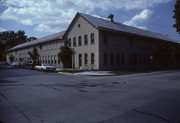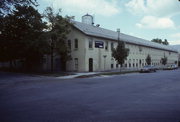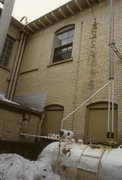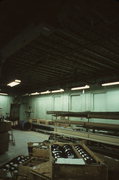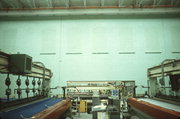Property Record
600 E ATLANTIC/625 E HANCOCK
Architecture and History Inventory
| Historic Name: | Appleton Wire Works |
|---|---|
| Other Name: | Albany International Corp. |
| Contributing: | |
| Reference Number: | 40127 |
| Location (Address): | 600 E ATLANTIC/625 E HANCOCK |
|---|---|
| County: | Outagamie |
| City: | Appleton |
| Township/Village: | |
| Unincorporated Community: | |
| Town: | |
| Range: | |
| Direction: | |
| Section: | |
| Quarter Section: | |
| Quarter/Quarter Section: |
| Year Built: | 1896 |
|---|---|
| Additions: | |
| Survey Date: | 1991 |
| Historic Use: | industrial building |
| Architectural Style: | Astylistic Utilitarian Building |
| Structural System: | |
| Wall Material: | Brick |
| Architect: | |
| Other Buildings On Site: | |
| Demolished?: | No |
| Demolished Date: |
| National/State Register Listing Name: | Appleton Wire Works |
|---|---|
| National Register Listing Date: | 9/4/2008 |
| National Register Multiple Property Name: |
| Additional Information: | A 'site file' exists for this property. It contains additional information such as correspondence, newspaper clippings, or historical information. It is a public record and may be viewed in person at the Wisconsin Historical Society, Division of Historic Preservation-Public History. Additional map codes are: 6/25 FRV7/4-6. Additional photo codes are: FRV7/4-6. Appleton Wire Works was the first wire cloth company in the Midwest. It was founded by William Buchanan, Gustavas E. Buchanan and Albert Weissenborn in 1895. The company started production in 1896. In 1896, the plant occupied two lots and contained four looms. In 1932, the plant covered an entire block and contained 60 looms for the manufacture of machine wire and wire cloth for paper and pulp mills. The first addition (80'x 140') was constructed in 1905. Four of the largest looms on the market were added, which increased output 20% and the total number of looms to 25. In 1906, Albert Weissenborn invented the electro-pneumatic loom. This improved quality and reduced the amount of labor needed. The company grew at a rapid pace. In 1906, six more looms were addded. In 1907, an electric power plant (44'x 55' with an 85' stack) was constructed. In 1909, a 40'x 120' two story brick addition was constructed. In 1910, 15 more looms were added. In 1916, a 35'x 104' warehouse and annealing room were added. In 1938, the company became the largest Fourdrinier wire weaving company in the world. William Buchanan was the president and treasurer at this time. In 1950, a second plant was built in Montgomery, Alabama. In 1955, Appleton Wire Works purchased the assets of International Wire Works, Menasha and Capital Wire, Ottawa in 1964. The name of the Appleton plant was changed to Appleton Wire in 1974. The entire company changed its name to Albany International in 1969. |
|---|---|
| Bibliographic References: | The Appleton Review, Essential Industries Keep City Prosperous, Appleton's 75th Anniversary Celebration, 1932, p. 11, 32. Eighty Years of Excellence, Appleton Wire, Appleton, WI 5/22/1976. |
| Wisconsin Architecture and History Inventory, State Historic Preservation Office, Wisconsin Historical Society, Madison, Wisconsin |

